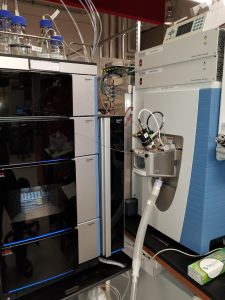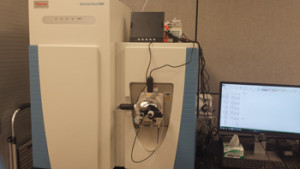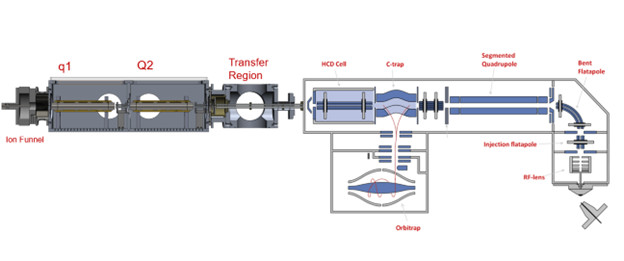 Thermo Scientific Q Exactive UHMR
Thermo Scientific Q Exactive UHMR
A benchtop Ultra High Mass Range (UHMR) hybrid quadrupole-Orbitrap instrument which enables analysis of extra-large molecules (m/z 350-80,000) with high mass accuracy. The UHMR is equipped with a higher-energy collision-induced dissociation (HCD) cell capable of acceleration voltages up to 300 V, as well as in-source trapping capabilities for improved declustering of ions. The Wysocki lab has two of these instruments and they are both modified with custom surface-induced dissociation (SID) devices. The UHMRs are primarily used for analysis of proteins and protein complexes by both direct infusion and online non-denaturing separation techniques. One instrument was purchased with funds from P41GM128577 and the other is part of a direct collaboration with Thermo Scientifics

Thermo Scientific Exactive Plus EMR and Reverse Entry Ion Source (REIS)
A benchtop Orbitrap instrument with extended mass range (EMR) that enables analysis of large molecules (m/z 350-20,000) with high mass accuracy and is equipped with a variable pressure higher-energy collision-induced dissociation (HCD) cell. This instrument has been modified to include a high-mass range quadrupole mass filter and a custom surface-induced dissociation (SID) device. The EMR is primarily used for the analysis of proteins and protein complexes by both direct infusion and online non-denaturing separation techniques.
The reverse entry ion source (REIS) is a modular platform for instrument development interfaced into the HCD cell of a Thermo Exactive Series EMR in collaboration with the Russell lab at TAMU 1. The REIS allows for extensive instrument modifications to be done without disrupting commercial functionality. Currently, the instrument is affixed with a custom-built dual quadrupole box. The selection quad (Q2) is run using digital waveform technology for the higher-resolution mass selection. This instrument has a SID device that can be easily added after the quad box. In addition, progress is being made towards adding an ion mobility drift tube onto the instrument to allow for mobility measurements to be collected in addition to high-resolution orbitrap data2.

Reference:
- Poltash ML, McCabe JW, Patrick JW, Laganowsky A, Russell DH. Development and Evaluation of a Reverse-Entry Ion Source Orbitrap Mass Spectrometer. J Am Soc Mass Spectrom. 2019 Jan;30(1):192-198. doi: 10.1007/s13361-018-1976-0.
- Jacob W. McCabe, Benjamin J. Jones, Thomas E. Walker, Robert L. Schrader, Adam P. Huntley, Jixing Lyu, Nathan M. Hoffman, Gordon A. Anderson, Peter T. A. Reilly, Arthur Laganowsky, Vicki H. Wysocki, and David H. Russell. Implementing Digital-Waveform Technology for Extended m/z Range Operation on a Native Dual-Quadrupole FT-IM-Orbitrap Mass Spectrometer Journal of the American Society for Mass Spectrometry 2021 32 (12), 2812-2820. DOI: 10.1021/jasms.1c00245
Waters Select Series Cyclic Ion-Mobility Separation (IMS)
The Waters SELECT Series Cyclic IMS q-cIM-TOF instrument has high sensitivity, high m/z resolution (>100k FWHM), and a unique cyclic ion mobility (cIM), allowing increased ion mobility resolution via multiple ion mobility passes. The instrument includes a commercialized split-lens surface-induced dissociation device which is controlled by the instrument’s default software. Additionally, this instrument has been upgraded to include an externally controlled electron capture dissociation device suitable for top-down mass spectrometry and electron-based charge reduction. Both the surface-induced dissociation and electron capture devices were included through collaboration with the manufacturer. This instrument was purchased in part with supplement funds from P41GM128577 for method development for the characterization of protein and protein complexes.
Bruker timsTOF Pro
A trapped ion mobility spectrometry (TIMS)/quadrupole/time-of-flight mass spectrometer. TIMS is a high-resolution ion mobility technique that separates the ions using an electric field gradient and drift gas flowing counter-current to the ion flow. When in its commercial configuration, this instrument can be used for metabolomics and proteomics. Moreover, the instrument has been modified for native mass spectrometry by upgrading the TIMS cartridge and lowering the radio frequency (RF) quadrupole RF generator. A custom surface-induced dissociation (SID) device is in front of the collisional cell to investigate the structures of protein complexes.
Refeyn TwoMP Mass Photometer
Mass photometry (MP) is a solution phase technique that measures masses of biomolecules using scattered light at a glass-water interface. It is an easy-to-use technique that provides masses within minutes while using minimal sample amounts (generally in the nanomolar concentration range). MP utilizes biomolecule calibrants with known molecular masses to obtain analyte masses with ± 5% accuracy. The TwoMP model measures masses in the range of 30 kDa to 5 MDa, allowing the characterization of mass and stoichiometry of proteins, nucleic acids, and their complexes, as well as larger viral particles like AAVs.



